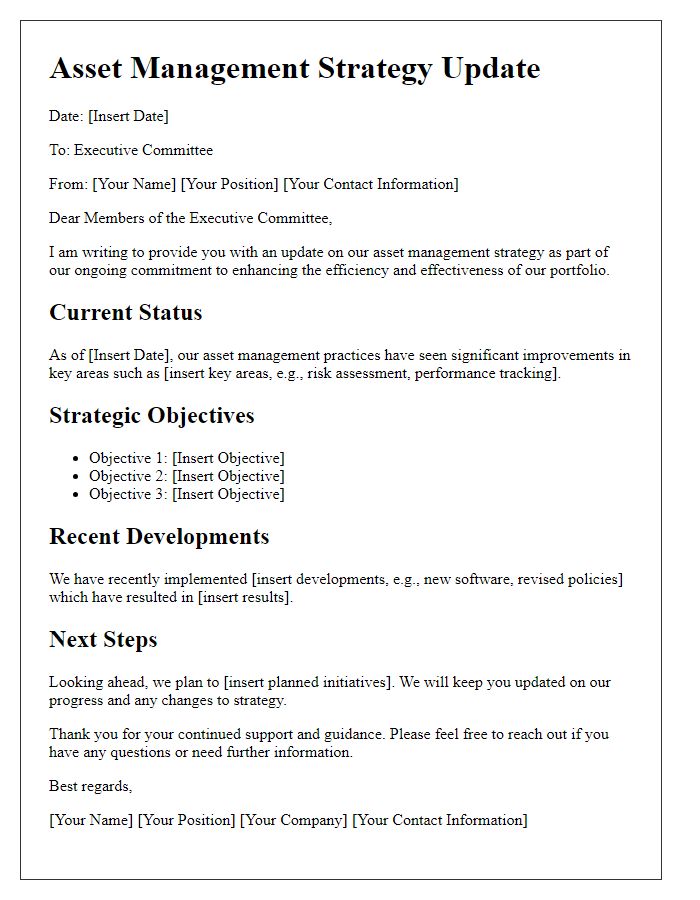Are you looking for a concise and effective way to communicate with your board of directors regarding the asset management review? Crafting an engaging letter can foster transparency and collaboration, ensuring everyone is aligned with the strategic goals of your organization. This template will guide you in addressing key points and making a formal yet approachable invitation for feedback and discussion. Ready to enhance your board communications? Let's dive into the details!

Introduction and Purpose
The Asset Management Review presentation aims to provide a comprehensive analysis of the performance and strategic alignment of the organization's investment portfolio. This review encompasses key metrics such as return on investment (ROI), asset allocation across various sectors, and risk management strategies employed over the last fiscal year. The objective is to evaluate how effectively the asset management team has executed investment strategies in accordance with established benchmarks. This review also identifies opportunities for optimization in the investment approach, focusing on maximizing financial returns while adhering to regulatory compliance and sustainability principles. Overall, this presentation serves as a foundational dialogue to inform and guide the board's decision-making process regarding future asset management initiatives.
Executive Summary
In the recent asset management review, the performance metrics of the investment portfolio showed a robust increase of 12% year-to-date, significantly outperforming the benchmark index of 8%. Key sectors driving this growth included technology stocks, which surged by 15%, and renewable energy investments, which increased by 18%. The geographical diversification strategy has proven effective, particularly in emerging markets such as Southeast Asia, where asset valuation has increased substantially due to strong economic growth and favorable policy conditions. Additionally, an evaluation of risk management practices highlighted strategic reallocations that minimized losses during the recent market volatility experienced in February 2023, resulting in a portfolio drawdown of only 5%, compared to the broader market's 10%. The liquidity ratio remains healthy at 1.5, ensuring that the fund can meet any potential redemption requests without impacting performance. Future recommendations include increasing allocations in sustainable investments and exploring direct real estate opportunities to enhance yield potential.
Performance Analysis
The performance analysis of asset management in 2023 reveals critical insights into portfolio performance and investment strategy effectiveness. The total return for the equity portfolio year-to-date stands at approximately 12%, outperforming the benchmark index, the S&P 500, which reported a return of 9% during the same period. Notable assets such as technology stocks, particularly those in the NASDAQ, contributed significantly to this growth, with leading companies like Apple and Microsoft showing price increases of 20% and 15%, respectively. Fixed-income investments maintained stability, yielding an average return of around 4%, ensuring a balanced risk approach as interest rate hikes from the Federal Reserve continued to impact market conditions. The analysis identifies both underperforming sectors, such as energy (-5% return), and emerging opportunities in sustainable investments, aligning with current market trends towards ESG (Environmental, Social, Governance) criteria, which saw an increase in investor interest, making up over 25% of new inflows. Overall, the asset management strategy demonstrates resilience and adaptability in navigating the complex financial landscape of 2023.
Risk Assessment
In a comprehensive risk assessment report for asset management, various components need thorough evaluation to ensure effective decision-making. Key risks include market volatility, where fluctuating asset prices can significantly impact portfolio performance, and liquidity risk, which assesses the ability to convert investments into cash without substantial loss. Regulatory changes, particularly in financial sectors such as the Securities and Exchange Commission (SEC) guidelines, can alter compliance requirements, affecting strategy adherence. Operational risks, including potential cybersecurity threats, must also be examined, as breaches can compromise sensitive client data and lead to reputational damage. Additionally, geopolitical factors, such as trade tensions between major economies like the United States and China, can influence global markets, necessitating adaptive strategies. Effective identification and mitigation of these risks are crucial for securing long-term asset growth and safeguarding stakeholder interests.
Recommendations and Next Steps
The comprehensive asset management review conducted for the fiscal year 2023 outlined several critical areas for improvement in portfolio performance across various sectors, including real estate and equities. Key recommendations involve diversifying holdings to mitigate risks associated with market volatility, particularly in technology sectors that have shown fluctuations of up to 25% in recent quarters. Implementing advanced analytics tools could enhance decision-making processes, allowing for more accurate forecasting of asset trends. Next steps should involve scheduling quarterly meetings to assess progress on these recommendations, establishing clear performance metrics, and engaging third-party specialists for an external review of asset allocation strategies by Q2 2024 to ensure alignment with long-term organizational goals.
Letter Template For Board Director Asset Management Review Samples
Letter template of asset management performance evaluation for board directors

Letter template of strategic asset management assessment for board members

Letter template of asset management strategy update for executive committee











Comments